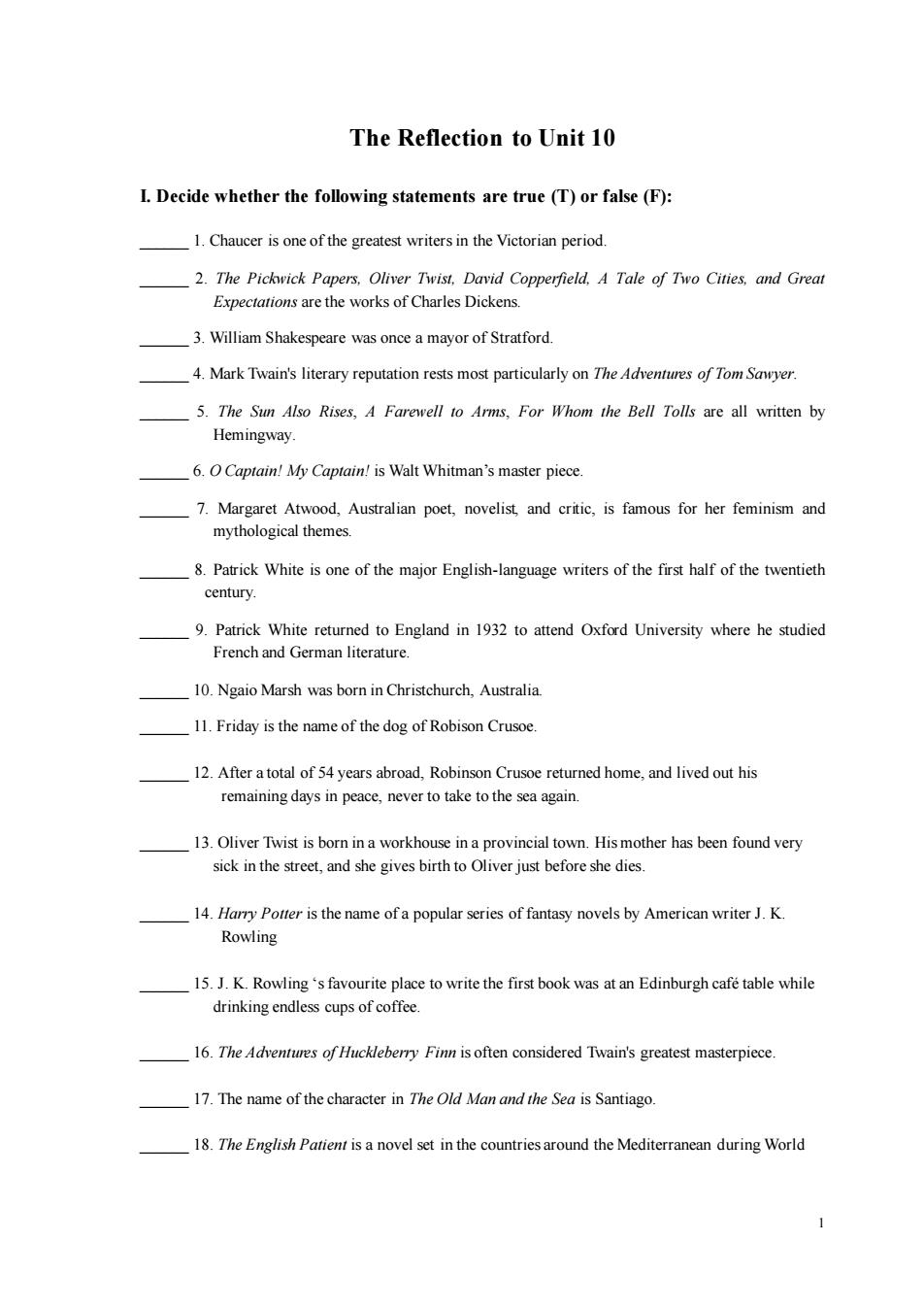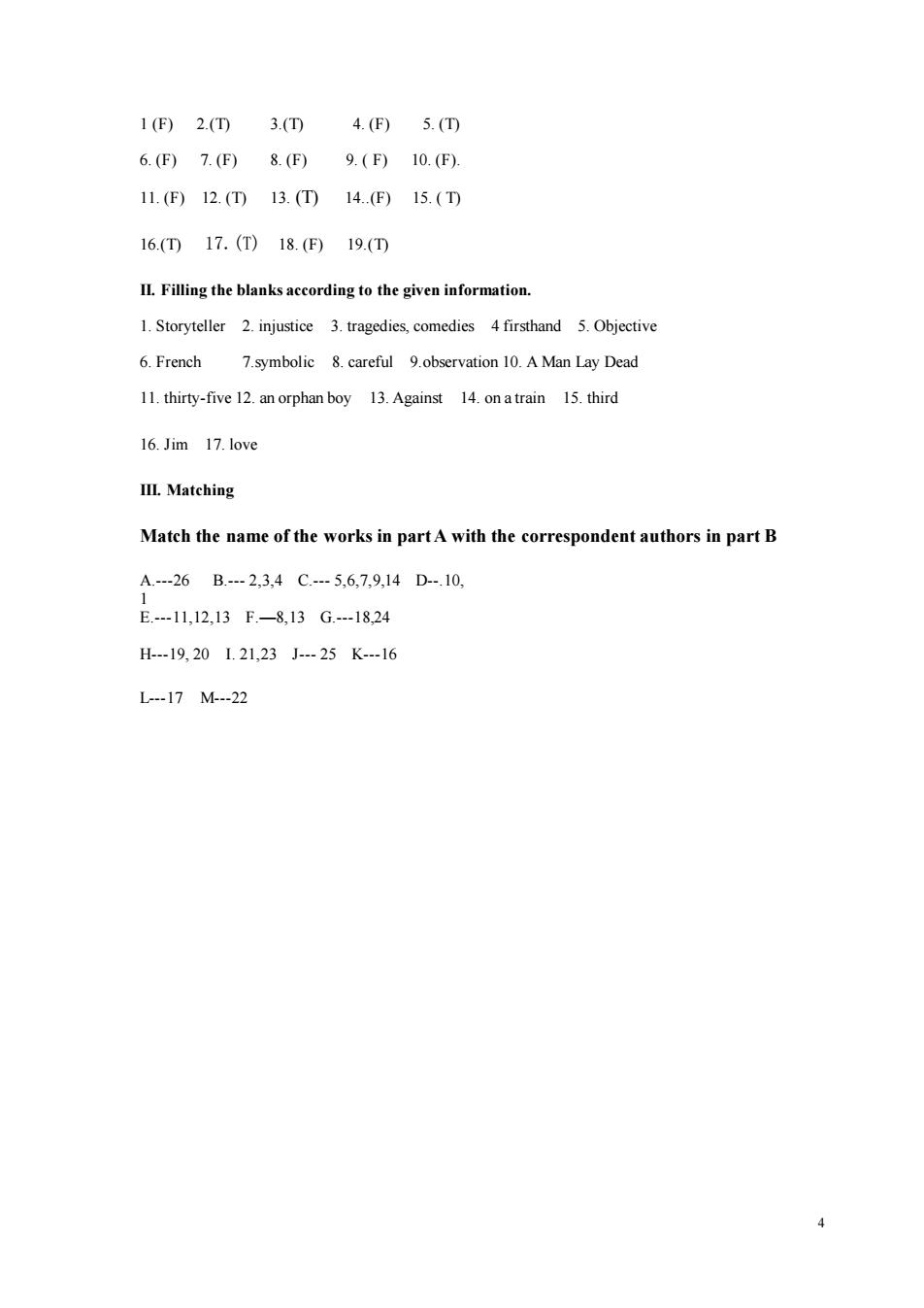
The Reflection to Unit 10 I.Decide whether the following statements are true (T)or false(F) 1.Chaucer is one of the greatest writers in the Victorian period 2.The Pickwick Papers,Oliver Twist,David Copperfield.A Tale of Two Cities,and Great Expectations are the works of Charles Dickens. 3.William Shakespeare was once a mayor of Stratford 4.Mark Twain's literary reputation rests most particularly on The Advenes f 5.The Sun Also Rises,A Farewell to Arms,For Whom the Bell Tolls are all written by Hemingway. 6.Captin!My Captain!is Walt Whitman's master piece. 7.Margaret Atwood,Australian poet,novelist and rtc,is famous for her feminism and mythological themes 8.Patrick White isone of the major English-anguage writers of the first half of the twentieth century. 9.Patrick White retured to England in 1932 to attend Oxford University where he studied French and German literature. 10.Ngaio Marsh was born in Christchurch,Australia 11.Friday is the name of the dog of Robison Cruso 12.After atotal of 54 years abroad,Robinson Crusoe returned home,and lived out his remaining days in peace,never to take to the sea again 13.Oliver Twist is born in a workhouse in a provincial town.Hismother has been found very sick in the street,and she gives birth to Oliver just before she dies. 14.Hany Porter is the name ofa popular series of fantasy novels by American writer J.K. Rowling 15.J.K.Rowling's favourite place to write the first book was at an Edinburgh cafe table while drinking endless cups of coffee. 16.The Adventes of Huckleberry Finn is often considered Twain's greatest masterpiece. 17.The name of the character in The Old Man and the Sea is Santiago. 18.The English Patient is a novel set in the countries around the Mediterranean during World
1 The Reflection to Unit 10 I. Decide whether the following statements are true (T) or false (F): ______ 1. Chaucer is one of the greatest writersin the Victorian period. ______ 2. The Pickwick Papers, Oliver Twist, David Copperfield, A Tale of Two Cities, and Great Expectations are the works of Charles Dickens. ______ 3. William Shakespeare was once a mayor of Stratford. ______ 4. Mark Twain's literary reputation rests most particularly on The Adventures of Tom Sawyer. ______ 5. The Sun Also Rises, A Farewell to Arms, For Whom the Bell Tolls are all written by Hemingway. ______ 6. O Captain! My Captain! is Walt Whitman’s master piece. ______ 7. Margaret Atwood, Australian poet, novelist, and critic, is famous for her feminism and mythological themes. ______ 8. Patrick White is one of the major English-language writers of the first half of the twentieth century. ______ 9. Patrick White returned to England in 1932 to attend Oxford University where he studied French and German literature. ______ 10. Ngaio Marsh was born in Christchurch, Australia. ______ 11. Friday is the name of the dog of Robison Crusoe. ______ 12. After a total of 54 years abroad, Robinson Crusoe returned home, and lived out his remaining days in peace, never to take to the sea again. ______ 13. Oliver Twist is born in a workhouse in a provincial town. His mother has been found very sick in the street, and she gives birth to Oliver just before she dies. ______ 14. Harry Potter is the name of a popular series of fantasy novels by American writer J. K. Rowling ______ 15. J. K. Rowling ‘s favourite place to write the first book was at an Edinburgh café table while drinking endless cups of coffee. ______ 16. The Adventures of Huckleberry Finn is often considered Twain's greatest masterpiece. ______ 17. The name of the character in The Old Man and the Sea is Santiago. ______ 18. The English Patient is a novel set in the countries around the Mediterranean during World

WarI. 19.Tree isawork of considerable accomplishment and originality,and confirmsJo Kinisellaa of themjorEnglish-anguge poets ofour generatior II.Filling the blanks according to the given information. 1.Chaucer is a of genius.Like Shakespeare after him,he drew his stories from many sources. 2.Dickens's works are characterized by attacks on social evilsand hypocrisy. 3.Shakespeare's plays fall into two categories _and】 4.Mark Twain usually wrote about his own personal experiences and things he knew about from experience. 5.Hemingway used the point of view and his vocabulary and sentence structure are deceptively simple 6.Many of Walt Whitman's poems contain words of derivation. 7.Atwood's fiction is often She has moved easily between satire and fantasy,and enlarged the boundaries oftraditional realism. 8.Patrick White's writing style is solid,but also very daring-is captivating.and the reader can never be certain of what will come next 9.In Atwood's book the events are seen through the eyes ofthe main character,whose weapon is irony and keen -she keeps a secret diary. 10.In 1934 her first novel is finished,which introduced her detective Inspector Roderic Alleyn. 11.On June 11,1687, years after his earlier visit Robinson Crusoe arrived in England. 12.Oliver Twist was written by Dickens in 1837-38.It tells the story of whose adventures rovidea the ower depths of London. 13.Monks'plot_ Oliver is disclosed by Mr.Brownlow 14.According to the author,the main character Harry Potter appeared in her head while she was from Manchester to London in 1991 15.Series of Harry Potter are written in person limited omniscient mode,with Harry as the central character. 16.The most important characters in The Adventures of Huckleberry Finn are Huck and 17.In Santiago's relationsh ipwith the world and those around him.Hemingway had discovered a way to proclaim the power of in a wider and deeper way than in his previous works
2 War I . ______ 19. Lightning Tree is a work of considerable accomplishment and originality, and confirms John Kinisella as one of the major English-language poets of our generation. II. Filling the blanks according to the given information. 1. Chaucer is a ______of genius. Like Shakespeare after him, he drew his stories from many sources. 2. Dickens's works are characterized by attacks on social evils, _____, and hypocrisy. 3. Shakespeare’s plays fall into two categories: _______and _______. 4. Mark Twain usually wrote about his own personal experiences and things he knew about from ____experience. 5. Hemingway used the _____ point of view and his vocabulary and sentence structure are deceptively simple. 6. Many of Walt Whitman’s poems contain words of ______derivation. 7. Atwood's fiction is often _____. She has moved easily between satire and fantasy, and enlarged the boundaries of traditional realism. 8. Patrick White’s writing style is _____, solid, but also very daring -- is captivating, and the reader can never be certain of what will come next. 9. In Atwood's book the events are seen through the eyes of the main character, whose weapon is irony and keen ________-she keeps a secret diary. 10. In 1934 her first novel _______ is finished, which introduced her detective Inspector Roderick Alleyn. 11. On June 11, 1687, _____ years after his earlier visit Robinson Crusoe arrived in England. 12. Oliver Twist was written by Dickens in 1837-38. It tells the story of _________, whose adventures provide a description of the lower depths of London. 13. Monks’ plot ____ Oliver is disclosed by Mr. Brownlow. 14. According to the author, the main character Harry Potter appeared in her head while she was_____from Manchester to London in 1991 15. Series of Harry Potter are written in ____ person limited omniscient mode, with Harry as the central character. 16. The most important characters in The Adventures of Huckleberry Finn are Huck and ______ 17. In Santiago’s relationship with the world and those around him, Hemingway had discovered a way to proclaim the power of _____in a wider and deeper way than in his previous works

III.Matching Match the name of the works in part A with the correspondent authors in part B A 1.Life on Mississippi 14.Othello 2.David Copperfield 15.OCaptain!My Captain 3.A tale of Two Cities 16.Harry Potter 4.Oliver Twist 17. The English Patient 5.Macbeth 18 The Edible Woman 6.Romeo and Juliet 19.The Tree of Man 7.Hamlet 20.The Eye of the Storm 8.Leaves of Grass 21.A Man Lay Dead 9.A Midsu 22 Lightning Tre 10. 23 Enter a Murderer 11.The Sun Also Rises 24.Cat's Eye 12.For whom the Bell Tolls 25.Robinson Crusoe 13.The Old Man and the Sea 26.The Canterbury Tales B A.Chauce B.Charles Dickens C.Shakespeare D.Mark Twain F Walt Whi G.Margaret Atwood H.Patrick White I.Ngaio Marsh J.Daniel Defoe K.J.K Rowling L Michael Ondaatjc M.John Kinsella Keys to Unit 10 I.Decide whether the following statements are true(T)or false(F):
3 III. Matching Match the name of the works in part A with the correspondent authors in part B A. 1. Life on Mississippi 2. David Copperfield 3. A tale of Two Cities 4. Oliver Twist 5. Macbeth 6. Romeo and Juliet 7. Hamlet 8. Leaves of Grass 9. A Midsummer Night’s Dream 10. The Adventures of Huckleberry Finns 11. The Sun Also Rises 12. For whom the Bell Tolls 13. The Old Man and the Sea 14. Othello 15. O Captain! My Captain 16. Harry Potter 17. The English Patient 18. The Edible Woman 19. The Tree of Man 20. The Eye of the Storm 21. A Man Lay Dead 22. Lightning Tree 23. Enter a Murderer 24. Cat’s Eye 25. Robinson Crusoe 26. The Canterbury Tales B. A. Chaucer B. Charles Dickens C. Shakespeare D. Mark Twain E. Ernest Hemingway F. Walt Whiteman G. Margaret Atwood H. Patrick White I. Ngaio Marsh J. Daniel Defoe K. J.K Rowling L. Michael Ondaatje M. John Kinsella Keys to Unit 10 I.Decide whether the following statements are true (T) or false (F):

1(F)2.(m3.(m4.(F)5.(① 6.F)7.()8.(E9.(F)10.F) 11.()12.(m13.(①14.(F)15.(TD 16.(①17.(T)18.(F)19.() II.Filling the blanks according to the given information. 1.Storyteller 2.injustice 3.tragedies,comedies 4 firsthand 5.Objective 6.French 7.symbolic 8.careful 9.observation 10.A Man Lay Dead 11.thirty-five 12.an orphan boy 13.Against 14.onatrain 15.third 16.Jim 17.love ⅢMatching Match the name of the works in partA with the correspondent authors in part B A-26B-2,34C.-5,6,79,14D-10, E.-ll,12,13f.-8,13G.-1824 H-19,201.21,23J-25K-16 L-17M-22
4 1 (F) 2.(T) 3.(T) 4. (F) 5. (T) 6. (F) 7. (F) 8. (F) 9. ( F) 10. (F). 11. (F) 12. (T) 13. (T) 14..(F) 15. ( T) 16.(T) 17.(T) 18. (F) 19.(T) II. Filling the blanks according to the given information. 1. Storyteller 2. injustice 3. tragedies, comedies 4 firsthand 5. Objective 6. French 7.symbolic 8. careful 9.observation 10. A Man Lay Dead 11. thirty-five 12. an orphan boy 13. Against 14. on a train 15. third 16. Jim 17. love III. Matching Match the name of the works in part A with the correspondent authors in part B A.---26 B.--- 2,3,4 C.--- 5,6,7,9,14 D--.10, 1 E.---11,12,13 F.—8,13 G.---18,24 H---19, 20 I. 21,23 J--- 25 K---16 L---17 M---22